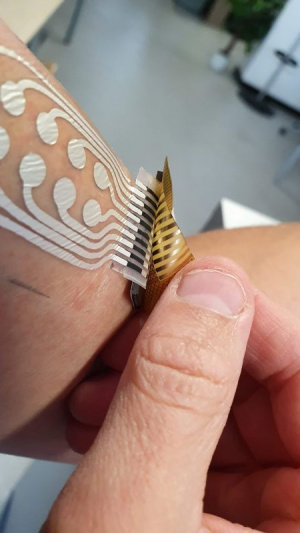Difference between revisions of "Flexible Electronic Systems and Embedded Epidermal Devices"
From iis-projects
| Line 4: | Line 4: | ||
==Flexible Electronic Systems and Embedded Epidermal Devices== | ==Flexible Electronic Systems and Embedded Epidermal Devices== | ||
| − | Flexible | + | Flexible Electronic Devices incorporate polymers and other flexible or strechable materials, to create wearable and conformable devices. These system are often composed of various flexible, bendable or small ridgid active and passive components, such as electrodes, transducers, transistors up to complete ICs or energy storage units. |
| − | + | ||
| + | There are several challenges associated with the development and implementation of flexible electronic devices such as: | ||
| + | |||
| + | * Material properties: Finding suitable materials that are flexible, stretchable, biocompatible, and have the required electronic properties can be difficult. | ||
| + | * Reliability: Flexible electronic devices are subjected to repeated stretching, bending, and other mechanical stress, which can affect their reliability and lifespan. | ||
| + | * Integration: Integrating multiple flexible components, such as sensors, transistors, and energy storage units, into a single device can be a complex and challenging process. | ||
| + | * Fabrication: Fabricating flexible electronic devices requires advanced and specialized techniques, such as printing, lamination, or transfer-printing, which can be difficult to implement at scale. | ||
| + | * Interconnectivity: Ensuring that flexible electronic devices can communicate with other devices, such as smartphones and computers, can be challenging. | ||
| + | |||
| + | This allows for comfortable wear, while the integration of digital electronic components enables the devices to perform a wide range of functions, such as continuous monitoring and modulation of physiological signals or the communication with other devices. | ||
| + | |||
| + | |||
| + | |||
| + | The system are composed of various flexible active and passive components, such as electrodes, transducers, transistors, or energy storage units, that are integrated into a single, thin, and lightweight substrate. | ||
| + | |||
Revision as of 21:07, 5 February 2023
Contents
Flexible Electronic Systems and Embedded Epidermal Devices
Flexible Electronic Devices incorporate polymers and other flexible or strechable materials, to create wearable and conformable devices. These system are often composed of various flexible, bendable or small ridgid active and passive components, such as electrodes, transducers, transistors up to complete ICs or energy storage units.
There are several challenges associated with the development and implementation of flexible electronic devices such as:
- Material properties: Finding suitable materials that are flexible, stretchable, biocompatible, and have the required electronic properties can be difficult.
- Reliability: Flexible electronic devices are subjected to repeated stretching, bending, and other mechanical stress, which can affect their reliability and lifespan.
- Integration: Integrating multiple flexible components, such as sensors, transistors, and energy storage units, into a single device can be a complex and challenging process.
- Fabrication: Fabricating flexible electronic devices requires advanced and specialized techniques, such as printing, lamination, or transfer-printing, which can be difficult to implement at scale.
- Interconnectivity: Ensuring that flexible electronic devices can communicate with other devices, such as smartphones and computers, can be challenging.
This allows for comfortable wear, while the integration of digital electronic components enables the devices to perform a wide range of functions, such as continuous monitoring and modulation of physiological signals or the communication with other devices.
The system are composed of various flexible active and passive components, such as electrodes, transducers, transistors, or energy storage units, that are integrated into a single, thin, and lightweight substrate.
Our Activities
Contact
Christoph Leitner
|
Projects
All projects are annotated with one or more possible project types (M/S/B/G) and a number of students (1 to 3).
- M: Master's thesis: 26 weeks full-time (6 months) for one student only
- S: Semester project: 14 weeks half-time (1 semester lecture period) or 7 weeks full-time for 1-3 students
- B: Bachelor's thesis: 14 weeks half-time (1 semester lecture period) for one student only
- G: Group project: 14 weeks part-time (1 semester lecture period) for 2-3 students
Usually, these are merely suggestions from our side; proposals can often be reformulated to fit students' needs.
Available Projects
- Adaptively Controlled Polarization And Hysteresis Curve Tracing For Polymer Piezoelectrics (1 S/B)
- Development Of A Test Bed For Ultrasonic Transducer Characterization (1 S/B)
- Towards Flexible and Printable Wearables

